September 19, 2023
by Carole Zangari -
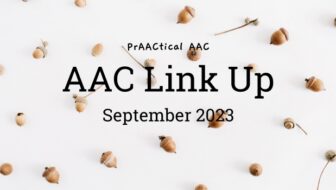
Happy Tuesday, AAC friends! Once a week, we invite you to share your own AAC-related content, product news, or anything else that you’d like others in the AAC community to know about. It may be a recent post you’ve written, a slide deck from your AAC presentation, a handout, video, or meme that you’ve posted online, an AAC product you’ve created, an announcement for an AAC course or conference, or any other prAACtical content you developed and want to share with the AAC community. To post your own link, scroll all the way down to the bottom of this post and complete the form. Enter the URL and the name/title in the boxes provided below. If you are on a mobile device, click over to the full website version to do this. The AAC Link Up is moderated to keep us from being spammed, so it may take a little... [Read More...]
Filed under: AAC Link Up, Featured Posts
September 17, 2023
by Carole Zangari -
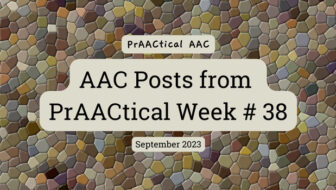
Happy Sunday, AAC friends. Here are some posts you might enjoy. Monday – AAC Intervention For Multicultural Families – Similarities and Differences Across Cultures Tuesday – AAC Link Up Wednesday – Video of the Week: Alternative Access for AAC on the iPad ::::::::::::::::::::::::::::::::::::::::::::::::::::::::::::::::::::::::::::::::::::::::::::::::::::::::::: If you have time, here are a few more posts to check out. PrAACtical Suggestions: 5 Ways to Elicit Language Without Asking a Direct Question Are you AACtually Listening? PrAACtical Suggestions: How to Get Started with A New AAC Client PrAACtical Questions: How Do I Find Good AAC Service Providers?
Filed under: Featured Posts
September 12, 2023
by Carole Zangari -
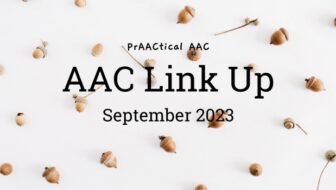
Happy Tuesday, AAC friends! Once a week, we invite you to share your own AAC-related content, product news, or anything else that you’d like others in the AAC community to know about. It may be a recent post you’ve written, a slide deck from your AAC presentation, a handout, video, or meme that you’ve posted online, an AAC product you’ve created, an announcement for an AAC course or conference, or any other prAACtical content you developed and want to share with the AAC community. To post your own link, scroll all the way down to the bottom of this post and complete the form. Enter the URL and the name/title in the boxes provided below. If you are on a mobile device, click over to the full website version to do this. The AAC Link Up is moderated to keep us from being spammed, so it may take a little... [Read More...]
Filed under: AAC Link Up, Featured Posts
September 11, 2023
by Carole Zangari -
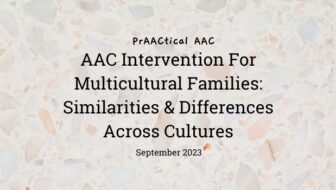
Across the world, AAC teams are looking for ways to strengthen their support of multilingual individuals with complex communication needs. In this article, guest authors Hsiao-Ting Su and Wen-Hsin Ku, who are both bilingual Mandarin-English SLPs, share their thoughts. AAC Intervention for Multicultural Families – Similarities and Differences Across Cultures Though there are limited AAC resources in minority languages at this time, SLPs should make every effort to meet the needs of multicultural families. It is crucial for SLPs to keep cultural differences in mind when working with multicultural families. As two bilingual English-Mandarin-speaking SLPs who have worked with both families in the U.S. and Taiwan, we have first-hand experience navigating similarities and differences across cultures. Here, we describe some of the similarities and differences we have encountered most frequently. Similarities: Families worry that AAC will hinder verbal communication development Families need reassurance that it is okay for children to... [Read More...]
Filed under: Featured Posts
September 10, 2023
by Carole Zangari -

Happy Sunday, AAC friends. Here are some posts from our prAACtical week. Tuesday – AAC Link Up Wednesday – Video of the Week: The Intersection of AAC and Success Thursday – Cultural-Linguistic AAC: Inclusive Practices Using the TELL ME Program & Other Materials ::::::::::::::::::::::::::::::::::::::::::::::::::::::::::::::::::::::::::::::::::::::::::::::::::::: We’ve got a few more posts for you to browse. On the Same Page: Helping Team Members Recognize and Respond to Unconventional Communication Signals From Referential to Descriptive Teaching with AAC Learners Aided Language Input – How Much Language Should We Model? PrAACtical Resources: Promoting Inclusion and Participation for People Who Use AAC When Students are Reluctant to Use AAC: 5 Things to Try
Filed under: Featured Posts
September 7, 2023
by Carole Zangari -
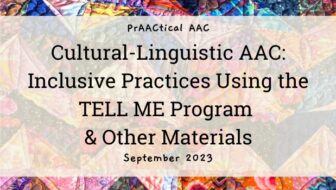
We are excited to continue our series on multilingual AAC support, guest-authored by BilingüeAAC. In today’s post, one member of the team, Melissa Tapia, addresses ways to use specific instructional materials with bilingual individuals. BilingüeAAC is a group of SLPs with a shared belief in providing evidence-based intervention strategies and resources to bilingual Spanish AAC clients, families, caregivers, and professionals. Inclusive Practices Using Tell Me Program & Other Materials How can we effectively conduct inclusive practices in our work settings? What are some approaches or materials that we can use to integrate the culture of the home and community? Why are inclusive practices essential for the success of our students/clients? These are fundamental reflective questions I have found to guide me in collaborative therapy and lead to better participation with and from my clients and their caregivers. We are Bilingue AAC, and we are here to provide helpful tools to... [Read More...]
Filed under: Featured Posts
September 3, 2023
by Carole Zangari -
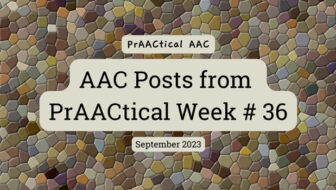
Happy Sunday, AAC friends. Here are some posts that might come in handy. Monday – September Year of Core Vocabulary & School Year of Core Vocabulary Words Tuesday – AAC Link Up Wednesday – Video of the Week: AAC Fundamentals for Families Thursday – Throwback Thursday: AAC Support for Beginning Communicators Friday – PráctiCAAmente Conectados: CAA Con Links – Septiembre 2023 ::::::::::::::::::::::::::::::::::::::::::::::::::::::::::::::::::::::::::::::::::::::::::::::::::::::::::::::: In the mood for some more AAC? Here are some selections from our archives. Video Modeling & AAC Boosting Communication with Video Modeling PrAACtical Teaching in the ASD Classroom: Predictable Chart Writing with Core Vocabulary How We Do It: AAC Videos for Core Word Modeling
Filed under: Featured Posts
August 31, 2023
by Carole Zangari -
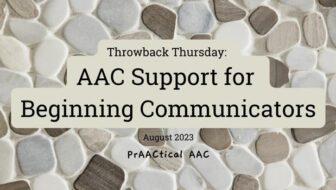
There is a lot to consider when working with people who are in the early stages of communicative development. If you are planning an assessment, preparing for therapy or instruction, or otherwise supporting an emergent communicator, these past posts may be of interest. Recommended Practices for Beginning Communicators Using Symbols with Beginning Communicators Getting Started with AAC Helping Beginning Communicators Expand Their Sentences A PrAACtical Literacy Activity for Beginning Communicators Beginning Communicators: Learning Through Touch Cues The Role of Meaning Making with Beginning Communicators: Motivating Interactions Influencing People’s Perception of Beginning AAC Users: 3 Things to Try
Filed under: Featured Posts
August 28, 2023
by Carole Zangari -
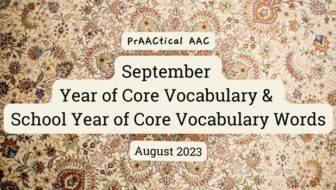
In 2013, when schools and other clinical programs were expanding their emphasis on teaching core vocabulary words, Robin Parker and I developed a set of resources for families and professionals that included symbol cards, sample sentences to model, activity suggestions, and more. All of these were based on a small set of core words for each month (see that post here). We followed that with a second set of Year of Core Vocabulary Word resources for a new list of words (click here for that post). Over the years, the resources were expanded and grew to include a wonderful series of calendars with daily activity suggestions developed by AAC SLP and co-founder of Talking AAC, Rachael Langley. There were many other contributors over the years who added to these efforts. In 2020, a new series was launched, School Year of Core Vocabulary Words, authored by guest contributors Michaela Sullivan, Alisa... [Read More...]
Filed under: Featured Posts
August 27, 2023
by Carole Zangari -
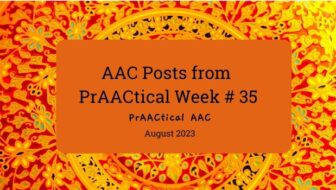
Happy Sunday, AAC friends. We have some posts that you might enjoy. Tuesday – AAC Link Up Wednesday – Video of the Week: AAC & the Power of Pretend Play Thursday – Throwback Thursday: AAC at School ::::::::::::::::::::::::::::::::::::::::::::::::::::::::::::::::::::::::::::::::::::::::::::::::::::::: Here are a few more for your browsing pleasure. AAC and Visual Supports for Storms and Hurricanes: 10 Useful Resources How I Do It: Cooking in the Classroom with Carol Goossens’ How I Do It: Conversation Practice with Teens and Young Adults by Angela Adams On AAC Training: Skill Building for AAC Team Members PrAACtical Resources: AAC 101 Flipbook Handout
Filed under: Featured Posts









